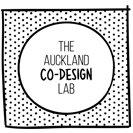A perspective on co-design in Aotearoa New Zealand
by Penny Hagen
The term co-design has become ubiquitous across government over the last 5 years, including in significant strategies, reports, engagement models and procurement requirements.
The Auckland Co-design Lab itself represents a continued and growing interest by the Aotearoa New Zealand public service in the potential of co-design of policy, services and community-led responses, aimed at enabling greater participation and more effective responses to complex social and economic issues.
We believe that co-design, when practised well, and used to refer to culturally grounded participatory and developmental design practices shaped by and with people in place, offers the potential for improved community wellbeing outcomes. It is an opportunity for people to impact, lead, and shape the things that influence their lives. For this potential of co-design to be realised, the role of tangata whenua is fundamental. When led by Māori for Māori as an expression of te ao Māori values and tīkanga, co-design is seen by some Māori practitioners as representing an opportunity for whānau Māori to participate in mana enhancing ways and lead change in their own lives (see for example Menzies et. al. (2017) and Whaanga-Schollum et. al. (2016)).
It also poses significant risk when done poorly. For the ‘co’ in co-design to be honoured, there needs to be more than design skills and methods involved. Both the capability and the conditions for a relational and value-based, culturally grounded practice based on reciprocity and shared decision-making need to be in place. Doing co-design involves creating time, space and structures for learning, reciprocity, and power sharing. Delivering on co-design means allowing for changes to how policy, procurement and services are currently configured. These represent significant shifts for most public service teams. This is especially true when government is commissioning codesign that impacts Māori. While the intent of co-design is promising, there is still a lot of work needed to close the gap between potential, capability, conditions and, in some cases, the commitment needed to follow through and deliver on this potential.
To date, co-design practice has been inconsistent and variable in quality. Co-design has, in some spaces, already become a fancy word for consultation, or to infer a degree of power sharing, participation and partnership that never really existed. The concern that outcomes from co-design might not be honoured or followed through by government is genuine. Also worryingly, co-design risks being an imported process that perpetuates colonial and Eurocentric mindsets and values, rather than providing a means to enact Te Tiriti o Waitangi/The Treaty of Waitangi 2 (‘Te Tiriti’) or be understood as related to practice already existing within te ao Māori. From our own experience and from practitioner reports, we know that many in the community already distrust the term co-design, are experiencing a form of ‘co-design fatigue’, and can consider the term to be devalued of meaning.
---------
The above is part of the opening section of our 2020 report, Co-design in Aotearoa New Zealand: a snapshot of the literature. The report was co-authored with Toi Āria: Design for Public Good College of Creative Arts Toi Rauwhārangi Massey University. It scanned existing readily available literature on co-design across academic and public domains in Aotearoa New Zealand (up to September 2019). Our intent from the review, though not exhaustive, was to help to make the current landscape of formal scholarship and research visible for those practicing or commissioning co-design in Aotearoa New Zealand.
A synopsis of key points from the snapshot includes:
» A significant emphasis of co-design in the New Zealand health sector, with literature potentially reflecting the influence of the UK National Health Service practice of experience-based design.
» Co-design is seen by many as providing a powerful method to connect with those using or impacted by services and products. This brings their experiences to shape a solution to a problem, and, more importantly, to define the problem itself.
» Co-design was also valued for capability building. This is visible particularly for youth-focused projects, but increasingly also as an aspect of working with whānau and organisations.
» Māori practitioners are leading a strong and emerging practice that explores the potential of approaches based in kaupapa Māori or tīkanga Māori practice and principles. It signals the relationship between co-design and the principles of Te Tiriti, and the tension that exists between dominant eurocentric models and culturally grounded, indigenous and place-based practices.
» A need to invest more in the integration of evaluation and co-design. A number of questions are raised about the resources, skills, investment and conditions required for co-design and its ethical practice.
Click here for the full review.
In addition to the references included in the review, an appendix of abstracts or summaries from the reports and papers is also provided, to make access for others seeking co-design resources easier. We hope to able to continue to build on this index of resources over time and welcome additions to add to our growing Aotearoa based resource list, which will be available shortly online. If you have NZ based resources or writing you’d like to share - please contact us.

